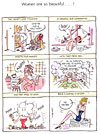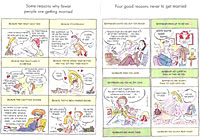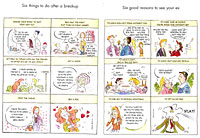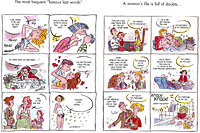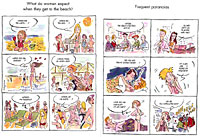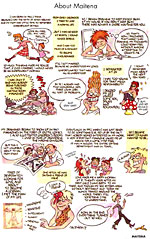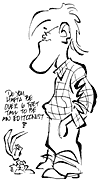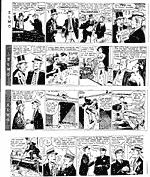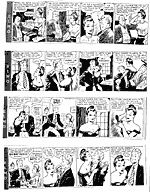 |
|||||||
|
Opus 152:
Opus 152 ( NOUS R The Katzenjammer Kids had an anniversary on December 12: it reached the ripe
old age of 107, the oldest comic strip still in circulation. Created
by Rudolph Dirks in 1897, the Sunday-only
strip is continued today by Hy
Eisman, who also produces the Sunday Popeye,
another long-running strip that is celebrating its 75th year
these days, most notably, last week on December 17 when Fox-tv aired
the CGI animated cartoon in which the one-eyed sailor goes searching
for his father, Poopdeck Pappy. ... Stan
Lynde, creator of Rick O'Shay and, later, Latigo and the panel of homespun western
humor, Grass Roots-not to
mention five western novels-designed the uniform patch recently adopted
by Montana's federal marshals; the patch depicts a lone rider setting
out at dawn to hunt down the bad guys. ... Garry
Trudeau, creator of Doonesbury,
made the 90th slot on USAToday.com columnist Whitney Matheson's
list of the top 100 pop culture figures of 2004. Matheson cited the
episode in which B.D. lost his leg while fighting in In October, U.S. Customs seized copies of Top Shelf Productions'
Stripburger Nos. 4-5 and 37,
charging that the stories "Moj Stub" by Bojan Redzic and "Richie Bush" by Peter Kuper constituted "clearly piratical copies" of registered
and recorded copyrights. "Moj Stub" ("My Pole")
is an 8-page ecological parable in which some Peanuts characters appear briefly; "Richie Bush" is a 4-page
parody of Richie Rich that also satirizes the Bush League by superimposing
the personalities of the Cabinet on the comic book characters. The Comic
Book Legal Defense Fund has retained counsel to challenge the seizure.
Said Chris Staros, president
of both CBLDF and Top Shelf: "The comics in question are clearly
within the acceptable bounds of parody, and there is absolutely no likelihood
that consumers would confuse these works with the subject that they
are parodying." CBLDF Executive Director Charles
Brownstein agrees, adding: "The charge that these are piratical
copies of existing copyrights is not only wrong-headed but the seizure
amounts to an unlawful prior restraint of protected speech." If you've ever wondered why Tintin, the perpetual boy journalist invented by Belgian cartoonist
Herge, has never, in 23 published
adventures since his inception in 1929, grown up, you are not alone.
A light-hearted article in the holiday edition of the Canadian Medical Association Journal explains it all in reporting
theoretical research by Antoine Cyr, age 6, his brother Louis-Olivier,
age 7, and their father, Claude Cyr, an associate professor of pediatric
medicine at the Stephan Pastis,
who has made himself an obnoxious character in his own strip Pearls before Swine, arrived, on Tuesday,
December 14, in Mark Tatulli's
strip, Heart of the City,
as the new music teacher. I'm not sure all this inter-strip chumminess
between cartooners is an advance in the art of comic strippery, but
let's see just how obnoxious Tatullli will make him. ... After a long
absence such as befits the senior partner in the strip's title, Steve
Roper made a surprise return to the strip, and he's spent most of
the month of December so far talking about his retirement plans with
Mike Nomad; as I mentioned a couple weeks ago, they'll both be retired
on December 29. ... In Darrin Bell's Candorville, the power went off in Lamont's apartment for several
days, which Bell spent plunging the strip's panels into solid black,
the only artwork being speech balloons and lettering; the next week
in Rudy Park, which Bell also draws, the power
went off, and Rudy and his friends in the cyber café were plunged into
solid black, the only artwork being speech balloons, lettering, and
eyeballs. That's two consecutive weeks' vacation for Politics Infest Strips.
Not news, by any means, except at Get Fuzzy, whose creator, Darby
Conley, once professed dislike for comic strips taking sides on
political or social issues. On December 12, Rob Wilco, Bucky Katt's
hapless owner, tells the feline, who is writing his autobiography, "Just
because you keep saying something doesn't make it true." The ever
irritable cat replies: "Yeah, but it makes stupid people think
it's true, stupid," adding, after a moment, "By the way, Mike Baldwin,
who, since 1996, has been producing a panel cartoon called Cornered, says "no tree has to die in vain" for the first
compilation of his cartoon, Cornered:
Don't Try Anything. Collecting more than 300 of his cartoons and
including a washingtonpost.com Q&A with The current issue of The
Comics Journal, No. 264, reprints 32 consecutive Little Joe comic strips, the Sunday-only creation of, it seems, Harold Gray, he of Little Orphan Annie fame. Initially written and drawn by Ed Leffingwell,
a background assistant to Gray, the strip started Cathy Guisewite,
creator of the perpetual Cathy,
whose eponymous heroine has been obsessing about her forthcoming
wedding (scheduled for February 5, 2005) for over ten months now, realizes
that her altar-bound couple, like many somewhat "older" people
verging toward nuptials, probably have everything they need in order
to set up (or continue) housekeeping. So Guisewite has registered Cathy
and Irving at http://www.thebigday.com/cathy
where visitors can choose from a number of items destined to benefit
a not-for-profit rescue organization for dogs and cats-such items as
"Happily Ever After Flea and Tick Baths," "Here Comes
the Dinner Bowl Meals," and "In Sickness and In Health Veterinary
Checkups." At the end of the three-month campaign (December 1 -
February 28), the money for the gifts will be presented to the Pet Orphans
of Southern California. Guisewite, who volunteers (with her daughter)
at Pet Orphans, got the ball rolling with a $1,000 donation. All those
who donate will receive a Thank You from the happy couple, including
an autographed copy of their wedding photo. We are often concerned about the absence of freedom of the
press in other, allegedly more backward, countries. But the tendancy
lurks here, too. In But I don't mean to suggest that the so-called free press
in this country is without fault. In fact, I agree with Wiley Miller who expressed his exasperation with If you're curious about conservative attitudes and can't
get enough by reading Mallard
Fillmore or the much less prickly Prickly
City, check into www.rightoons.com,
a website dubbed "Right Toons" (with a punning road-sign logo
depicting a right turn arrow), where Colin
Hayes publishes a satirical political strip called The
Leftersons (clever name) plus editorial cartoons by Bob Lang and Paul Nowak,
an outgrowth of the conviction that there aren't, apparently, enough
conservative comic strips and political cartoonists. In an informal
survey in 2002, Editor & Publisher
found that syndicates claim 19 "liberal" political cartoonists
among their combined rosters of syndicated editoonists while only 6
were "conservative." Recently on the e-mail list sponsored
by the Association of American Editorial Cartoonists, participants listed
by name 46 editorial cartoonists who were, by their own admission, "conservative."
Not all of that number are full-time editoonists, though; my estimate
is that only about 25 of them are. But if there are only about 90-100
full-time editoonists in the country, that means fully a quarter of
them are of the conservative persuasion. The percentage, in other words,
is about the same as E&P's
informal survey. Incidentally, just to anticipate the coming windstorm, in
The Boondocks during the week
immediately ahead, McGruder takes on Santa, introduced on Saturday,
December 18, as "a fat, old, self-hating Black man named Uncle
Ruckus,l" who, spying the little girl's Afro, says, "Girl,
your hair is nappier than a wolf's butt in a windstorm! I know somebody
who's gettin' some relaxer in her stocking!" Several newspapers
have already said they'll skip the current releases and re-run last
year's. Every so often-oftener than we'd like to think about it-we
encounter yet another news report detailing the pedagogical aspirations
of a school teacher or school system that has adopted comic books as
a sure-fire way of engaging "reluctant readers" in the academic
enterprise. Here's another one about a pilot program in "some parts
of And here is the cover illustration from the most recent
issue of The Cartoonist, bi-monthly
newsletter of the National Cartoonists Society: celebrating the 50th
anniversary of Hi and Lois,
a water-colored pencil drawing by Chance
Browne, who pencils the strip. This specimen vividly shows how his
pencil work looks before it is inked by Frank
Johnson. Under the Spreading Punditry Social Security, the blather
of the Bush League notwithstanding, doesn't need radical reformation.
According to most experts who are not politicians, the Social Security
funds are adequate until roughly 2040, and only a little tinkering (a
fraction of a percentage point of adjustment here or there in either
collection or disbursement) could get us well beyond the time that the
Boomer Generation is supposed to overwhelm the system. Or, let's say,
just remove the ceiling that establishes an upper limit on the amount
of earnings per year that are taxed by Social Security. The Bush League
wants to privatize the system, according to Paul Krugman in the
New York Times, as a purely ideological matter. This impulse, he
continues, is aided and abetted by financial corporations that would
dearly love to have more money to invest and otherwise play with. I
think it's the other way around, but the point is: the Social Security
system is not in need of drastic overhaul. Krugman has also surveyed
other countries that have privatized their social security systems to
see how it's working. It isn't. Privatization, he says, "dissipates
a large fraction of workers' contributions into management fees for
investment companies" and leaves many retirees in poverty. Management
fees can be reduced if the government does the investing; but if that's
the plan, then we're being lied to when GeeDubya says we'll get to manage
our own investments. In some countries where social security systems
have been privatized, the costs have gone up: when the private investments
don't pay off, the government must step in and fund the retirement of
persons who would otherwise be plunged into dire poverty. The Los Angeles Times
reports that the Army National Guard has fallen 30 percent short
of its recruiting goal in recent months. ... Nearly 900 children in
the Politicians are expert at dodging the issue and diverting
the argument. Discussing Rumsfeld's gaff and the failure of the Bush
League to adequately armor soldiers sent to Iraq, one esteemed member
of Congress, appearing on Capital Gang, deftly changed the subject:
"Surely," he said (or words to this effect), "you aren't
saying that President Bush and Donald Rumsfeld deliberately sent our
troops over there so unprotected as to court death and disaster?"
No, surely: none of us suggest that. But that changed the subject. Instead
of focusing on the ineptitude of the Bush Leaguers as war planners,
the topic was, suddenly, whether or not leading members of the administration
were, in effect, war criminals. No, of course they aren't war criminals:
they're simply inept and stubborn about it, but shifting the ground
of the discussion took our attention off the real subject-the incompetence
of the administration-and directed it to a phoney subject-the demonic
culpability of the Bush Leaguers. And since no one believes the latter,
the assault on the Bush League was skillfully shut down with everyone
seemingly agreeing that, no, no one in the Bush League was culpable
(even though the culpability being denied herewith was not the culpability
they were initially being accused of). The recent Rumsfeld flap in the press over armoring the
troops in Once a Month is Not Enough Just as I predicted, the Comics Buyer's Guide has gone Last Kiss Sells Comics One Panel at a Time John Lustig, who's a friend
of ours, has been producing a two-panel comic strip at the Comics Buyer's Guide for several years now. Called Last Kiss, it employs artwork from vintage
Charlton Comics, the rights for which Lustig acquired before launching
the series. For the conventional and, even, hackneyed scenes of budding
and/or frustrated romance depicted in By now, we all know the key to success. Graphic novels!
Trade paperbacks! Thick collections of cool comics disguised as respectable
books for the Barnes & Noble crowd! Right? So why is Last Kiss creator
John Lustig doing the exact opposite? "Instead of selling my work in massive books, I'm marketing
them one panel Lustig's "one panel at a time" sales come in the
form of a colorful line of Last
Kiss note cards and magnets. Featuring revised panels from Lustig's
outrageous CBG comic strip and Last Kiss comic books, they began reaching stores late this summer.
"We could have started out slow with a couple of dozen
images," said Lustig. "But I've been test marketing the images
for years-mostly selling them as hand-cut magnets at conventions, both
to comic fans and the general public. And they've always done extremely
well. People apparently like my sense of humor. So my wife and I decided
to gamble and we jumped into mass production with a full line of 48
magnets and 48 note cards." Lustig has regional sales reps for the "Frankly, our primary focus is selling to book, gift
and greeting card shops. It's a much bigger market than just the comics
community," said Lustig. "However, I'm inordinately tickled
by every sale we make to comic shops! I'm still a comics geek at heart!
And I know the comics community far better than my reps. So my wife
(Shelagh) and I are dealing directly with comics retailers rather than have
our reps do it. In the near future, we¹re going to put together boxed
sets of the cards and possibly the magnets. At that point, we'll approach
Diamond and others for distribution." And what about a book collection? "My agents are talking
to several mainstream publishers right now and things look very good,"
said Lustig. "Oddly enough, I think my note cards and magnets are
helping sell the publishers on Last
Kiss. The way I've developed the line is showing them that Last Kiss really does have mass appeal." Footnote from the Happy Harv: In this age of rampant creators'
rights, Lustig is more scrupulous about the artwork he's using than
he needs to be. Legally, his purchase of the rights to the Charlton
material gives him the right to use the artwork without paying anyone,
but "on several occasions," Lustig says, "I've paid modest
honorariums to creators-when I've made a substantial use of their work
and I know how to reach them." He has made no payments, though,
for the strips in CBG: "I'm just using a panel or two
of art and trying to keep track of all these bits and pieces would be
difficult. It would also be financially infeasible: CBG pays very little. (I'm not complaining so much as recognizing
a fact.)" Sometimes, Lustig commissions new artwork for the comic
book, and when he does, he pays the artists a fee. For the cards and
magnets, on the other hand, he's again using only individual panels
and no new artwork; what with the financial risk he's taking and the
minuscule portions of art, he's not, with an exception or two, compensating
the artists. A Final Note from Nicole Jantze about the Norm.com Michael Jantze's dutiful and devoted wife writes to tell us
of the state of Norm's drive for a new lease on life online: ] The final three weeks of my
drive to raise money for The Norm.com are here. It's My goal is 4,000 donations. We're not there yet, but we
are more than half I'm not asking for your donation if The Norm isn't your favorite comic strip. This isn't a charity. Don't
donate for any reason other than that you or a family member or friend
LOVE Michael's work (great gift idea, hint, hint). What do you get if
you join? A year-long membership to The Norm.com and new The Norm strips. Plus whatever else Michael is cooking up (yes, he's
thinking about "beta-testing" another strip on the site) all
for $25 a year. Of course, there's more benefits if you donate at a
higher level. Go to http://www.thenorm.com/subscribe/
for more details. We accept payments through Amazon Honor System, PayPal
payments as well as VISA, MasterCard and Amex through The Norm Store
(a secure Yahoo! Store). Thanks for your time. Have a great holiday
season and 2005. See you at The Norm.com! -Nicole Jantze Yes, there's still time to sign up. Go
there and do it. Funnybook Fan Fare Trigger No. 1 from Vertigo introduces us to a post-modern Orwellian
world run by a giant corporation called Ethicorp, whose profit-motive
and slogan, "We get the bad out,"qualifies it as a futuristic
glimpse of the world the Bush League is building for us while we are
distracted by the war in Ahhhh, Maitena! Every once in a while, something
comes along that is so bright and shining that it lights up your life.
In matters cartooning, I get lit up when I chance upon some new variation
on the ways words and pictures can be deployed in tandem to achieve
a comedy that transcends the words by themselves or pictures alone.
And when that new blend of the verbal and the visual embodies a novel
point of view or a fresh voice, the light vaults to incandescence, and
I am warmed as well as illuminated. The first page I looked at in Maitena's
Women on the Edge 1 brought
on a moment like the Millennium Falcon's first leap into warp speed
when the snap of light on the screen instantly catapulted sight into
feeling. The book (80 6x9-inch pages in paperback; Riverhead Books,
$12) reprints over 70 of the weekly comic strips by Maitena Burundarena,
a forty-ish Argentinean woman, who, since 1993, has been articulating
with wit and compassion the hopes and fears and frustrations of women
throughout Latin America. "Women are not all the same, but the
same things happen to us," says Maitena, who uses only her first
name professionally. "I talk about solitude, separation, falling
in love, anguish, failure, success, children-universal themes that everyone
experiences." Although she speaks most directly to women, Maitena's work has a much more universal appeal than her
Latin American success would suggest; the two book compilations so far
published (Women on the Edge 2
being the second; a third is on the way) have sold over a million
copies world-wide. Her drawings are simply but expertly rendered (no
fumbling inadequacies at anatomy, for example) and delicately colored
in pastels. Each page in the books prints one strip, typically 4 or
6 panels long, each panel a visual-verbal vignette that represents a
different aspect of the topic announced in the heading for that strip.
Under "Life Is Not Fair," for instance, the drawings depict
a good wife, terrific mom, born homemaker, respected working professional
in charge of her own life, who, in the last panel, assumes an anguished
expression and asks: "So why do I have to have cellulite?"
The pictorial progression, as in "Women Are So Beautiful ... !
which I've reprinted in this vicinity, is often ironic: here, the pictures
offer ironic contrast to the individual panel captions, concluding with
the resounding irony in the depiction of "being a woman is so easy."
Maitena's books and strips have recently attracted an international
following (which is certain to include the U.S. now that the books are
available here in English), but she is not eager to become the creative
engine that aggressive pursuit of newly opening opportunities would
entail. "They've offered me film scripts to write and animated
films to draw, but I'm not going to change my life for that," she
says. "Who says the better you're doing, the more you have to work?"
Right: I said she was a fresh breeze blowing. She had her husband, Daniel
Kon, formerly manager of Latin American rock groups, divide their time
between Argentina and Uruguay, where they have a seaside cottage. "Relations
[there]," says Maitena, "are based on one's personality and
not on fame. There's a bit of fleeing from the world in living there,"
she admits, "but it's because we're found a life that appeals to
us. It's a fishing village. I have my own garden. I can cook for myself.
I make ceviche and sashimi. I walk on the beach for an hour every day
and play with my daughter"-Antonia, who is four. Current Crop of Comic Strip Reprints: Part 3 of 3 Another of the commemorative
tomes before us is 27 Years of
Jeff MacNelly's Shoe: World Ends at Ten, Details at Eleven (210
8.5x11-inch paperback pages, black-and-white with color Sundays; $16.95),
edited by Chris Cassatt, MacNelly's long-time assistant on the strip,
and Susie MacNelly, the creator's widow. Why a 27-year anniversary?
Got me. But it's nice to have, whatever its motive. The editors have
adopted the popular scrapbook approach in assembling and presenting
the contents: in addition to short sequences from the stri MacNelly died of lymphoma in June 2000, a three-time winner
of the Pulitzer, and his brethren in the editorial cartooning fraternity
marked his passing with anecdotes that illuminated his personality rather
than his professional achievement. Not that they didn't admire him professionally.
At an editorial cartoonists convention years ago, MacNelly doodled on
a napkin while a particularly boring speaker droned on; when the speaker
finished, MacNelly got up to leave, and a horde of his colleagues rushed
up to grab the napkin he'd left behind. MacNelly was thoroughly unpretentious,
"happier," columnist Dave
Barry said, "drinking a beer with his plumber than having dinner
at the White House." Jim
Morin of the Miami Herald
wrote: "This man of such awesome talent never bragged, never
surrounded himself with a circle of sycophants, never acted as if he
were 'above' his audience or his fellow cartoonists." As an editorial
cartoonist, MacNelly was generally seen as conservative, but he was
more a spectator, more bemused by the passing show than outraged. He
was a clear-eyed observer of the human condition-particularly the condition
displayed by politicians. Some of us think of politicians as craven
power brokers with self-interest as their chief motivation. But to MacNelly-judging
from his cartoons-these political leaders are merely bigger buffoons
than most of us and therefore a greater inspiration to laughter. His
cartoons suggested that our proper response to these four-star bumblers
should be the chastisement that laughter inflicts rather than the ouster
than the ballot box can effect. After all, you can't defrock a naked
emperor, and MacNelly showed them naked often enough to make us familiar
with the anatomy of politics. But the comic strip was another story. MacNelly needed more
to do: an editorial cartoon every day scarcely drained him of hilarious
ideas that needed to be disseminated as widely as possible. A daily
comic strip would give him a spotlight that he could shine on every
human foible, not just the political horseplay. Besides, he'd always
wanted to do a comic strip. Why couldn't he do a daily strip as well
a daily editoon? "I was daring myself, really," he said. In
the conception stages, the strip was about humans, but MacNelly found
them "boring"; so he turned to animals, finally settling on
birds. He liked the idea of doing goofy drawings of them flying around
(and in the early years, they flew more than they have recently). "A
bird smoking a cigar is an interesting sort of bird," he said.
"You really want to listen to him. And it's zany on its face to
have a bunch of birds walking around with clothes on." Moreover,
birds, not being human, provided the perspective of an outsider on the
human condition, a perspective MacNelly felt comfortable with. From
Shoe's perch at the Treetop Tattler-Tribune (the newspaper
he started a month or so after the strip's debut on September 12, 1977),
MacNelly could ridicule human foolishness with complete abandon, and
he did, steering into all those inlets of human endeavor that his editorial
cartoon with its political emphasis had to ignore. For his cast, MacNelly
mined his own life. The title character, P. Martin Shoemaker, or "Shoe,"
was Jim Shumaker, MacNelly's first editor, a legendary personage in
North Carolina journalism. Shu edited the Chapel
Hill Weekly, came to work in tennis shoes, and chewed his way through
cigars all day long. The Perfesser's nephew, Skylar, was MacNelly at
the age of twelve. Like Skylar, MacNelly was, by his own admission,
"a terrible athlete. I couldn't do anything that a large person
is supposed to be able to do." The Perfesser was not, at first,
MacNelly in adulthood. But before long, MacNelly found himself turning
into the Perfessor. "It's terrifying," the cartoonist said.
The entire ensemble pecks its way through the book: Loon,
the air mail expert; Roz at whose dingy diner the crew often collects;
Madame Zuzu, the fortune teller; Senator Batson D. Belfry (wondrous
name), Irving Seagull, Wiz the computer mechanic, even the Perfesser's
aged DeSoto and, at the other extreme,
Muffy Hollandaise, a preppy girl summer intern (who, we learn
in the section "Where Are They Now?" is running an escort
service in Washington, D.C.)-and Bumpkins, the butler the Perfesser
(Cosmo Fishhawk) inherited from an eccentric uncle. A fifteen-page section
rehearses many of Skylar's experiences at summer camp, a popular annual
event in Shoe wherein we all
realize what Skylar never does: that his summer camp is a Marine Corps
training redoubt with picturesque names like Parris Island and Cherry
Point. Since MacNelly's death, the strip has been continued by Cassatt,
who roughs out the panels, Gary
Brookins, who reworks the roughs and inks the final versions, and
Susie MacNelly, who passes final judgement on the gags supplied by Bill
Linden and Doug Gamble. And there are enough pages of their work to
demonstrate that Shoe is in good hands. Hysterical Feetnit: The book says the first Shoe was published on September 13, 1977,
but everything else I've seen says September 12. And the 12th
was a Monday in 1977's September, a better jumping off place than a
Tuesday. I have no convenient way to reconcile these contradictory facts,
so I'll just leave them with you. MacNelly, incidentally, is often credited
as the first political cartoonist to simultaneously produce a syndicated
daily comic strip. Not quite so. Tim
Menees at the Pittsburgh Post-Gazette was the first
of the present generation: he started a strip about a would-be writer
and journalist, Wordsmith,
in 1976. But Wordsmith didn't last long. In the previous
generation of editoonists, we have Cecil Jensen at the Chicago
Daily News: he launched one of my favorite strips on October 28,
1946- Elmo, whose eponymous protagonist was a
sort of urban Li'l Abner except that Elmo was stupider than Abner. I
admire this kind of stupidity in a comic character.
And Elmo made it all seem so easy, too-smiling his bland, ear-to-ear
grin the whole time. I loved
it. Elmo spent most of his early career working in the office of a breakfast cereal manufacturer, Popnut Skrummies. Elmo actually owned the company. The previous owner, oppressed by the responsibilities of being a millionaire and owner, gave Elmo all his stock in the company. So Elmo went to work there, but he was too stupid to know that the owner of the company should be giving the orders. Instead, he took orders from the Commodore, an unscrupulous robber baron who was running the company at the time. The Commodore, seeking to get Elmo occupied with something to keep him out of his, the Commodore's, hair, hires a ecdyiast to work as Elmo's secretary. This is Sultry. And she is. Among the many things Jensen could draw was attractive wimmin.
Elmo's girlfriend from back
home, Emmaline, gets wind of all this and comes to the big city to keep
an eye on things. About this time, a cute moppet named Little Debbie
shows up and becomes the face on the cereal box, selling billions of
bushels of Popnut Skrummies. You can't keep a good sales girl down.
Before long, Elmo disappeared, and Little
Debbie was the name of the strip; it continued that way until it
ceased in 1961. Jensen's strip had a good long run, as you can see;
but it never achieved the stellar status that MacNelly's Shoe
did. MacNelly may not have been the first political cartoonist to
produce a daily comic strip concurrently with his editoons, but his
strip achieved a much larger circulation than any of its lesser known
predecessors in the genre and has lasted longer. The latest collection of Garry Trudeau's Doonesbury,
Talk to the Hand (152 9x10-inch paperback pages, French flaps; black-and-white
with color Sundays; $16.95), begins approximately August/September 2003
and ends approximately August/September 2004. You'd think with a strip
as closely attuned to current events as Doonesbury that the editors of the reprint volumes would take care
to peg the comic strip happenings to the real events they satirize,
or, at least, to provide some clue as to the initial publication dates.
You'd think. This volume starts with the carnival California campaign
of Arnold Schwarzenegger and ends with B.D. in rehab after he's lost
a leg in Iraq. Between these two benchmarks fall Duke's looting of Iraq,
Trudeau's offer of $10,000 to anyone who can prove that George W. ("aWol")
Bush fulfilled his Guard duty in Alabama (no winners, remember?), the
battlefield sequence during which B.D. lost his leg, the Sunday listing
of all the names of U.S. military personnel killed in Iraq through April
23, 2004 (for update, visit www.lunaville.org), and White
House discussions of Dick Cheney's colorful "fuck off" instruction
to Senator Leahy on the Senate floor-to mention only those events that
thrust Doonesbury into the news columns of the
nation's press time after time all year. A full year of political waggery
withal, and worth keeping Trudeau's record of it handy. "Rugrats," you may have heard, is the name of
a popular Nickelodeon animated cartoon about toddlers that started in
about 1991 and ran for 65 episodes. That was the plan. But the series
proved so popular that production resumed in 1997, and a comic strip
version was launched the next year, running for five years until 2003.
I paid no attention whatsoever to this phenomenon, thinking that I was
somehow beyond kiddie humor. But here I'm proven wrong with It's
a Jungle Gym Out There: A Rugrats Collection (128 8.5x9-inch paperback
pages, b/w; $10.95). Lee Nordling, who edited the strip all
five years, credits almost two dozen creative personnel-writers, pencilers,
inkers-who contributed to the enterprise over the years. Most strips
carry at least three bylines, and maybe it was the factory-like creative
process that turned me off without actually witnessing any of the product.
My bad. The gimmick for the tv series was that the adventures therein
were related more-or-less from a baby's point-of-view. Some of the strips
here do the same. But many of the gags have a satirical edge that's
entirely adult. Kids in swings observe that the sun was "over there
this morning" and "now it's way over there. Same thing yesterday."
In the last panel: "Wonder what'll happen tomorrie." On another
occasion, the little girl Angelica wanders through a Sunday strip, witnessing
all the male cast members in succession, burping, smearing food on themselves,
drawing on the wall, and the like; after a contemplative panel, she
says, "Sigh. I'll never find a husband." Tom the Dancing Bug
is another comic strip endeavor that I don't reach much. Launched
into the alternative journalistic environment in about 1990, Ruben Bolling self-syndicated the feature until 1997, when he signed
with Universal Press Syndicate. Tom's
forte is weighty irony, and while Bolling is deft at dissecting
the foibles and hypocrisies of the times, I can take only so much of
it at one sitting. But that, surely, is my shortcoming and not Bolling's.
In Thrilling Tom the Dancing Bug Stories (224 8.5x11-inch paperback
pages, b/w; $14.95), the cartoonist deploys all the genre in his arsenal-comic
strips, editorial-type cartoons, parodies, superhero comic books, even
diagrams-to flay his targets, the wayward fads and misguided causes
that plague us all. Here's a page, for instance, that begins with the
headline: Just As You're Morally Opposed to the Execution of Mentally
Retarded Criminals, You're Also Morally Opposed to the Slaughter of
Mentally Retarded Animals. That's Why You Only Eat SMART MEAT." Bolling's targets line up on both sides of the
political spectrum, but I suspect his conservative victims are not much
moved by his attentions: conservatives never understand irony. Steve Moore produces
a panel cartoon for newspaper sports sections called In the Bleachers in which he looks at sports in much the same way
that Gary Larson looked at
life in general (insects and cows in particular). In a tidy size (5x5-inch
paperback), 272 of Moore's manic gems about golf are available as Dibs on His Clubs ($9.95). As an indication of the content, the title
is what one of three golfers says as he watches the fourth of their
foursome being levitated into a flying saucer. A new collection of the
greeting card favorite that became the perennial polyanna of the funnies,
Ziggy, is out under the title Character Matters (128 8x8-inch paperback
pages, b/w; $10.95). Civilization's Last Outpost The anyule incitement is upon
us. In various hamlets from sea to shining sea, we are once again treated
to the spectacle of Concerned Citizens bringing legal action against
their civic authorities to eliminate all shreds of reference to the
Christian holiday from public areas, citing the dubious ground that
the State should do nothing in support of any religion. My guess is
that if all such public displays concentrated on Santa Claus, evergreen
trees, and endless strings of colorful lights, most such legal actions
would have no legs to stand on, and we'd all get suitable public festivities.
Then I suppose Christians would object to their religious event being
subsumed under rank commercialism and pagan ritual. Syndicated columnist
John Leo tackled this subject recently, and after ticking off a series
of wonderfully narrow-minded instances of objections to the season,
wound up in Florida, where, he says, "an elementary school concert
included songs about Hanukkah and Kwanzaa but offered not a single note
of Christmas music." To Leo, this suggested that the Forces of
Evil (that is, what he calls "the anti-Christmas" movement)
were picking on Christianity. Nope; sorry. Last I heard, neither Hanukkah
nor Kwanzaa are, strictly speaking, religious events; Christmas, on
the other hand, is. Elsewhere, in the same spirit, they've invented a new word
for it. Frank Costanza introduced "a Festivus for the rest of us"
in 1997 on "Seinfeld," but, not content with this, the ultimate
secularization of the seasonal celebration, the more fervent among us
have concocted a new portmanteau word that includes just about everything
one might love about the holidays in a wish for a Happy Chrismahanukwanzakah.
Meanwhile, at www.Chrismukkah.com,
Ron Gompertz who is Jewish, and his wife Michelle, daughter of a Protestant
minister, combine their holidays under Chrismukkah, "a sort of
great umbrella name for describing the chaos and whimsy and excitement
that goes on during the month of December." Chrismukkah began December
7, Pearl Harbor Day, and persists for an 18-day observance that coincides
neatly with the most desperate weeks of the traditional Yuletide shopping
season. Chrismahanukwanzakah fell on December 13, which, this year,
came on a Monday. We like the idea of celebrating chaos and whimsy and
excitement, and we admit that Happy Chrismahanukwanzakah has a nice
rhythmic sound to it, but now we don't know whether to decorate the
tree or to light nine candles or seven. Paralyzed with indecision, we'll
probably just tip an eggnog or two. With egg on our face, then, we hope
you'll continue as unabated as ever and enjoy in all directions as you
do. That's what we intend to do here at R&R online.
To find out about Harv's books, click here. |
|||||||

send e-mail to R.C. Harvey Art of the Comic Book - Art of the Funnies - Accidental Ambassador Gordo - reviews - order form - Harv's Hindsights - main page |
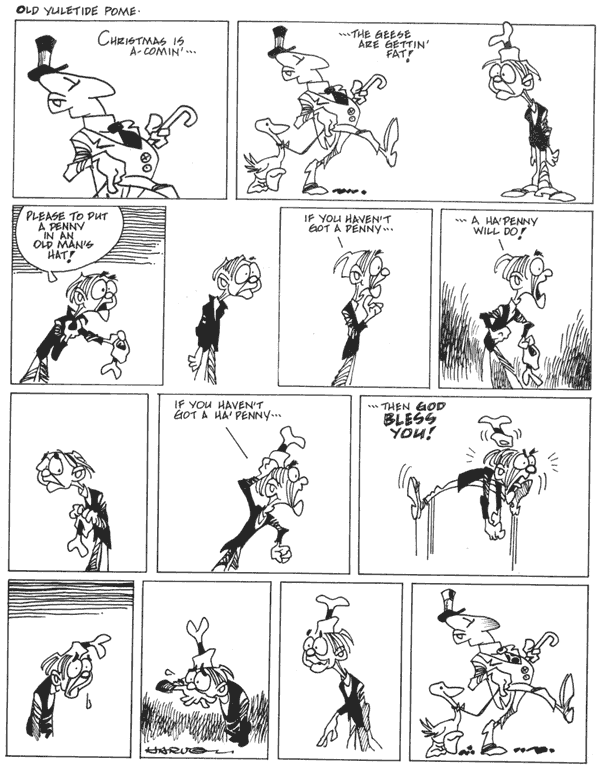
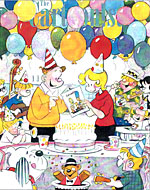

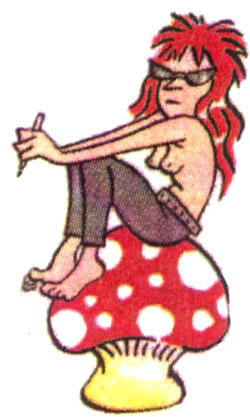 Larry
Rohter at the New York Times allowed
last winter as how "the popularity of her biting, satiric appraisal
of the sexes and their relations increasingly cuts across gender lines
as Latin American men, too, have begun to parse her comic strips for
clues to the female psyche." Rohter quotes Quino, another Argentine
cartoonist: "Spontaneous and direct, Maitena doesn't aspire to
be a mirror reflecting reality; on the contrary, she grabs hold of reality,
mirror and all, and throws it at our heads." Maitena's admirers,
Rohter notes, "regard her as a cultural phenomenon that simply
could not have existed fifteen years ago because she represents a "generational
transition" that has occurred throughout the region since then.
"Hers is a unique voice in Latin American society, looking at women's
issues with a sense of humor, humanity and frankness, and touching on
topics that are not usually talked about," said Mereles Gras, whose
magazine publishes Maitena's work in
Larry
Rohter at the New York Times allowed
last winter as how "the popularity of her biting, satiric appraisal
of the sexes and their relations increasingly cuts across gender lines
as Latin American men, too, have begun to parse her comic strips for
clues to the female psyche." Rohter quotes Quino, another Argentine
cartoonist: "Spontaneous and direct, Maitena doesn't aspire to
be a mirror reflecting reality; on the contrary, she grabs hold of reality,
mirror and all, and throws it at our heads." Maitena's admirers,
Rohter notes, "regard her as a cultural phenomenon that simply
could not have existed fifteen years ago because she represents a "generational
transition" that has occurred throughout the region since then.
"Hers is a unique voice in Latin American society, looking at women's
issues with a sense of humor, humanity and frankness, and touching on
topics that are not usually talked about," said Mereles Gras, whose
magazine publishes Maitena's work in 